A group of researchers, with the participation of the Doñana Biological Station – CSIC, has carried out a study to know if the predation rate of loggerhead turtle nests changes across thermal habitats and if sea turtles have the ability to choose nest sites with less predatory prevalence.
The study was conducted on Maio Island, in Cabo Verde, one of the main nesting places for the Northeast Atlantic loggerhead population, with 70 nests. The island displays marked heterogeneity of sand coloration, resulting in different thermal habitats: dark sand beaches are warmer than light sand beaches due to higher heat absorption. The turtles nest on all of them. This coloration heterogeneity is also present in other important sea turtle rookeries, for instance, Ascension Island and Cyprus.
The results show that there are no remarkable differences in the ghost crab density and size distribution across different beach types and years. There are differences in the predation rate: they are significantly higher on dark sand beaches. This finding shows that the potentially reduced embryo survival at these warmer beaches is not compensated by lower ghost crab predation. On the contrary, the lowest rates are found at mixed sand beaches and other causes are the ones that affect the most clutch survival.
In addition, data shows that mixed sand beaches have more nesting activity and higher nest density, compared to dark or light sand beaches, suggesting that nesting females may have the ability to choose those beaches with less predatory prevalence. This association between predation rate and nesting density might join other environmental cues that several studies suggest that sea turtles follow to select their nesting sites, such as sand moisture, temperature, elevation above the water level, and presence of vegetation.
This study reinforces the potential role of clutch protection as a conservation measure to reduce impacts affecting their survival. Multiple management techniques can be adopted. For instance, in areas subjected to flooding, it would be recommended to translocate clutches to safer zones or protected hatcheries, ensuring that natural beach conditions are maintained. In a global warming scenario, warm beaches might become extreme environments for sea turtle reproductive success. If eliminating ghost crab predation from dark sand beaches increases reproductive success, in situ nest protection should be enough. On the contrary, the translocation to a light sand hatchery might be prioritized. These managements may interfere on some level with interspecific relationships, thus the scientific team recommends that risk analyses must be conducted to assess their implementation.
Besides, the study opens new research lines. It would be interesting to know about the thermal tolerance range of ghost crabs or their ability to detect the scent of decomposing eggs and embryos, which may partly explain why the predation levels are higher at dark sand beaches, where the clutch survival is lower due to higher temperatures.
Referencia:
Rita Martins. Adolfo Marco, Juan Patino-Martinez, Kate Yeoman, Catarina Vinagre, Ana Rita Patrício. Ghost crab predation of loggerhead turtle eggs across thermal habitats. Journal of Experimental Marine Biology and Ecology. Doi: https://doi.org/10.1016/j.jembe.2022.151735









 Las altas temperaturas están provocando que las lagunas y las marismas de Doñana pierdan agua rápidamente
Las altas temperaturas están provocando que las lagunas y las marismas de Doñana pierdan agua rápidamente



